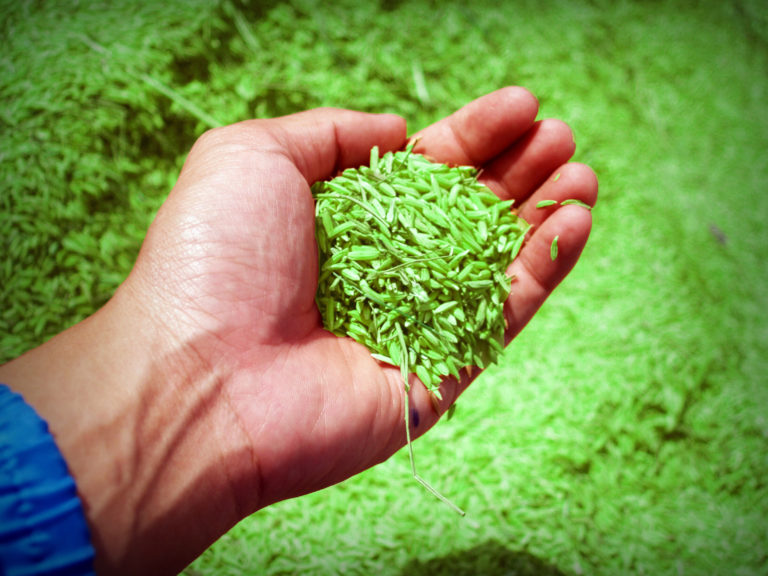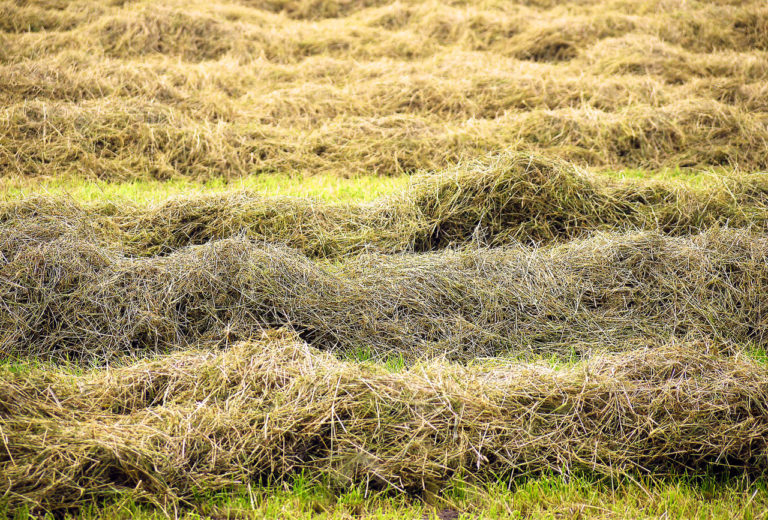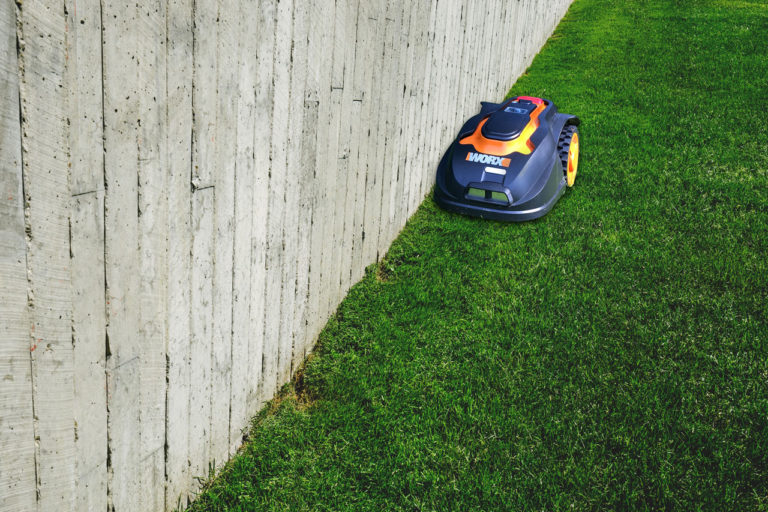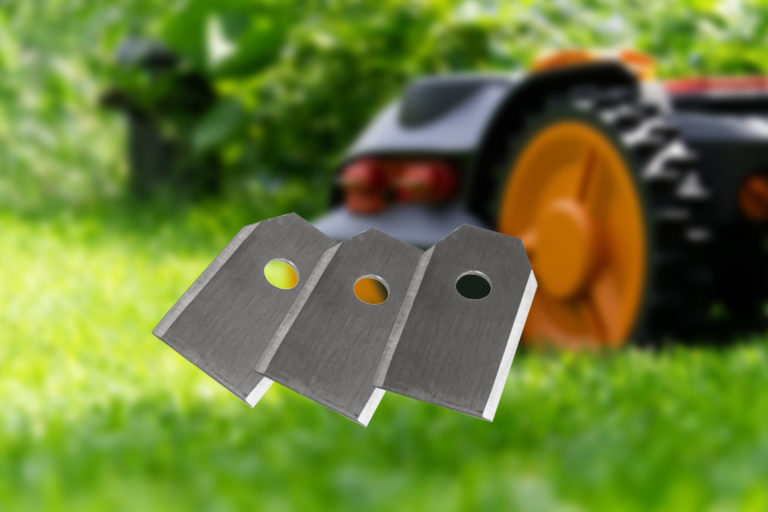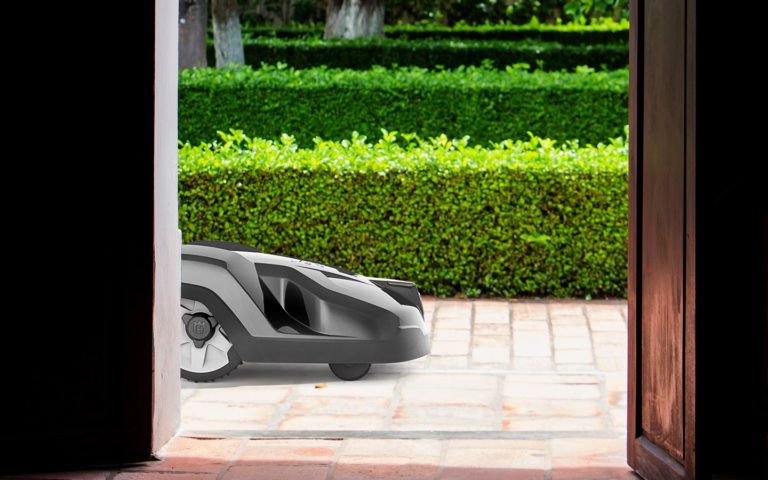Since robotic mowers are completely on their own when mowing, all kinds of stuff can get under their wheels. Leaves, branches, fallen fruit, pinecones, walnuts. What can the mowing unit of a robotic mower tolerate and what is too much for it? That also depends on the mowing unit of the robotic mower. There are different types of mowing units.
How much of an issue are leaves, branches, fallen fruit, or pinecones for robotic mowers? The lawn on which the robotic mower works should be as free of objects as possible. If objects that have fallen from the tree get into the mowing unit, the problem varies depending on the type mowing unit and the object. While a mower with a star cross can easily handle leaves, a pinecone in a blade disc mower can cause very big problems.
In this article you will learn how serious of an issue different lawn debris are, what problems to expect and what you can do about them.
Contents
What kind of tree debris is bad for the robotic mower?
Among the most common things that fall from trees in North America and cause problems for the robotic mower are leaves, branches, fallen fruit, pinecones, and walnuts. The problem varies with the size of the debris and also depends on the mowing unit.
As you may know, you can divide the mowing units of robotic mowers into two classes, in which there are still various subtypes.
So there are robotic mowers with blade discs and robotic mowers with star crosses. In general, robotic mowers with star crosses can handle objects better than robotic mowers with blade discs. If you compare the blades of both with each other, it will be completely clear why. Star crosses are simply much more robust.
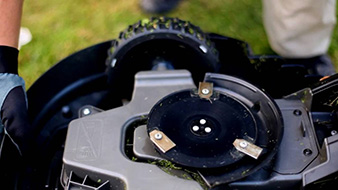
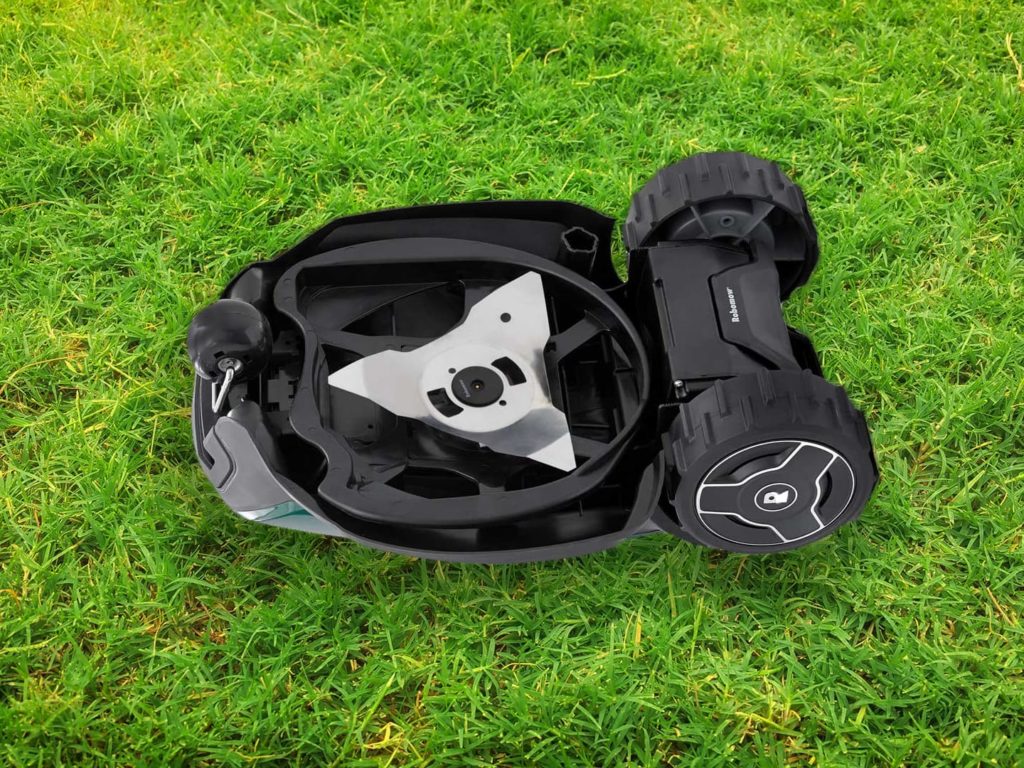
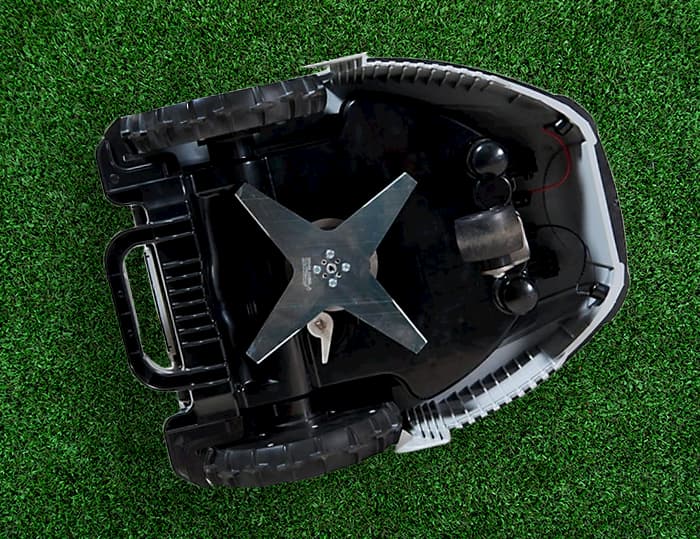
You may think that a robotic mower can be handy in removing leaves from the lawn, but it is not always an advantage if everything under the robotic mower is chopped into small pieces- especially if the piles of leaves are larger.
Take a look at this table to determine if your yard’s leaves will be a problem:
| Blade disc | Star cross | |
| Leaves/Foliage | Is only cut to size. Can also be removed after robotic mower operation. Larger quantities of leaves are problematic | If shredded, bigger quantities are problematic. Too much “leaf mulch” is bad for the lawn. |
| Branches | Problematic.Blades dull quickly. | Only thick branches are problematic. Small branches and twigs are OK. Blades dull somewhat. |
| Fallen fruit | Blades dull faster. Cuts notches into fallen fruit. | Blades dull slightly. Fallen fruit is chopped up. |
| Pinecones | Problematic. Seeds can wedge in the mowing unit. Heavy blade wear. Robot can high-center. | Problematic. Seeds can wedge in the mowing unit. Tobot can become high-centered. |
| Walnuts | Problematic. Blades become very dull. | Blades dull somewhat. |
Do leaves damage the robotic mower?
Let’s start with the most harmless one. Do leaves damage the robotic mower? Well, it depends. Above all, it depends on how much foliage is involved. But it generally does not cause great damage to the robotic mower. The blades simply dull a little faster.
However, there can be problems with the lawn.
Foliage and blade disc mowers
Small amounts of foliage don’t cause much of a problem, because the robotic mower simply drives over them and lightly chops them up. That being said, it is still a better idea to remove leaves before running the robotic mower, because the blades do wear out a little faster if they are chopping up leaves.
Lots of foliage can become a problem, especially when it is humid. This is not only because the blades wear out faster, but because the leaves also tend to stick to the wheels. This causes the robotic mower to lose grip on the ground, which can then either lead to the mower getting stuck somewhere or the robot slipping off slopes.
On slopes, too many leaves will also make the ground slippery, even if everything is okay with the wheels. Spinning wheels or even slipping can both leave visible damage to the lawn. Therefore it is better to rake up the leaves beforehand.
Leaves on mowers with star crosses
Small amounts of foliage are still a problem with these mowers. In contrast to robotic mowers with blade discs, robotic mowers with star crosses thoroughly chop up the leaves. This means that afterwards, it is much more difficult to collect the leaves. However, the blades on these models wear out much more slowly than do the blades on robotic mowers with blade discs.
A lot of foliage in combination with moisture becomes a problem here as well. Just as with robotic mowers that have blade discs, the leaves can either stick to the wheels or the robotic mower can slide on the leaves. This can be bad for the lawn, and the leaves also become chopped up.
Can robotic mowers mulch leaves? Too many chopped leaves, or “leaf mulch,” is not good for your lawn. This large amount of leaves cannot weather fast enough and in the long run a pile of chopped leaves will accumulate on your lawn.
So even if a robotic mower with a blade disc can handle larger amounts of leaves, you should do something good for your lawn and regularly remove the leaves.
What should you do with the leaves?
What is the best way to remove leaves from your lawn? Unfortunately there are no leaf collection robots yet, so you have to remove the leaves yourself. For a small area I would simply use a rake. Usually it should be enough to remove the leaves once a week.
For larger areas or if working with a rake is too tiring for you, a leaf blower is probably more suitable. As soon as there are robots that can take care of it, you will hear about it from me here on this blog
Can you avoid the sticking and slipping of the robotic mower? Some robotic mowers, such as many HUSQVARNA models, can be equipped with wheel brushes. These brushes clean the wheels almost continuously and remove dirt and even stuck-on leaves. This helps reduce the chances of your robot sticking or slipping on the lawn or leaves.
Do branches damage the robotic mower?
As far as branches are concerned, there are big differences between robotic mowers with blade discs and mowers with star crosses as their mowing unit.
Branches and robotic mowers with blade discs
Even thin branches and twigs are not so great for robotic mowers with blade discs. The very thin blades of these robotic mowers are simply not made for cutting coarse material.
If you have branches and twigs on your lawn and do not remove them regularly, the blades of your robotic mower will dull very quickly. So either you have to regularly walk your lawn and collect everything, or you better get a robotic mower with a star cross.
Branches and robotic mowers with star crosses
Robotic mowers with star crosses get along much better with branches and twigs and are the right choice if your yard frequently has fallen branches in it. If you live in a wooded area, definitely opt for a robotic mower with a star cross as the mowing unit.
The much harder and more robust blades of the star cross mowing unit can shred branches quite well, as long as they do not exceed a certain thickness. Nevertheless, you should not misuse your robotic mower as a wood chipper. If you have the opportunity, it is still better to collect branches and twigs yourself rather than letting the robotic mower do all the work.
Although the blades do not dull as quickly as on the blade disc, running over too many branches leads to faster wear and tear. Star crosses are generally much more expensive, so you should not be too careless with them.
Is there a solution to prevent falling branches getting in the way?
If you can’t constantly walk around the lawn to collect fallen branches, because you might be away for a long time, the most you can do is to stretch nets to catch falling branches and twigs. However, this might not always look so great, or even be feasible.
What do robotic mowers do with fallen fruit?
What about fruit that has fallen on the lawn? Smaller fruit varieties such as cherries are not such a big problem. Larger ones such as apples or pears are a problem. They also cause the blades to dull faster. If you have fruits with pits, such as peaches, growing in your yard, the pits of these fruits can be fairly damaging to the blades.
Fallen fruit and robotic mowers with blade discs
Robotic mowers with blade discs should avoid getting fallen fruit such as apples or pears into the mowing unit at all times. The blades will dull much faster as a result.
The fallen fruit itself will get scratched, but not chopped up. In an unfavorable case, the robotic mower may high-center on the fruit and get stuck.
Falling fruit and robotic mowers with star crosses
Robotic mowers with star crosses can handle fallen fruit much better. The very robust mowing unit chops the fallen fruit into small pieces. If you have a lot of fallen fruit in your lawn and you don’t have the possibility to collect the fallen fruit regularly, a robotic mower with a star cross might be the better choice for your lawn.
Tips on what you can do about fallen fruit on the lawn
If you don’t want to walk around your lawn all the time, collecting fallen fruit, I may have a solution for you.
With an apple guard, no fruit can get under the robotic mower. The apple guard is a kind of flexible strip that you can attach to the front of the robotic mower. The grass is able to bend and get under the blades, but the guard ensures that the robotic mower will simply push the fruit in front of it. Over time, the fruit will collect on the outer edges of the lawn. However, you can only use this apple guard if you have a very level lawn. Otherwise, the guard can get stuck on uneven lawn surfaces.
A tennis ball or walnut roller makes collecting fruit much easier. A tennis ball or walnut roller/gatherer is a flexible round metal cage that you roll along the ground with a long handle (like a mop). When you roll over the ground, the fruit gets picked up into the wire cage, but can’t get out. When the wire cage is full, you can empty it into a bucket. A walnut gatherer might work for smaller fruits, such as cherries or plums, but for larger fruits, a tennis-ball roller would be the way to go.
Are pinecones a problem for robotic mowers?
Pinecones are probably among the most problematic tree debris for the robotic mower. They can easily become wedged in the mower, or cause the robot to high-center and get stuck. The sap left on pinecones can also create quite a mess within the mower over time.
Fir cones, however, are no problem for the robotic mower. This is not because robotic mowers are particularly good at shredding them, but because fir cones do not fall from the tree, only their small seeds do.
Pinecones and robotic mowers with blade discs
Robotic mowers with blade discs are particularly bad at handling pinecones. It is more common for the cones to wedge themselves in these mowing units. And even if they don’t, the blades of the mowing unit wear out very quickly if they frequently come into contact with pinecones.
So if you have a lot of cones in your lawn, you have to do something about it before setting your robotic mower loose. If you already have a robotic mower in operation in your yard, you will surely have noticed this. Unfortunately there are not many solutions here. Your only option if you don’t want to regularly pick pinecones up by hand is to stretch a net to catch the cones before they make it to the ground.
Is there any way to protect robotic mowers with blade discs from pinecones? For some robotic mowers there is another possibility: You can install blade protection. This comes in the form of a kind of grid that you can install over the blades. But the problem is that this is not yet available as standard equipment and therefore the height adjustment is somewhat limited.
Pinecones and robotic mowers with star crosses
Robotic mowers with star crosses can handle cones a little better. At least the blades don’t dull as much and they do chop up the pinecones a bit, albeit with some considerable effort.
However, the cones may occasionally wedge together, making it more difficult for the robotic mower to handle them. In addition, you still have the problem with sap from the cones making a mess in the mower.
Like blade discs, star crosses also dull when constantly mowing over cones, although to a lesser degree.
Robotic Lawn Mowers and Walnuts
Nuts can also be problematic for robotic mowers. This is especially true for walnuts. If you have a walnut tree in your yard that yields many nuts and you do not manage to collect all of them, it is best not to use a robotic mower with a blade disc. However, robotic mowers with star crosses cannot actually “mow” with huge masses of these nuts, either.
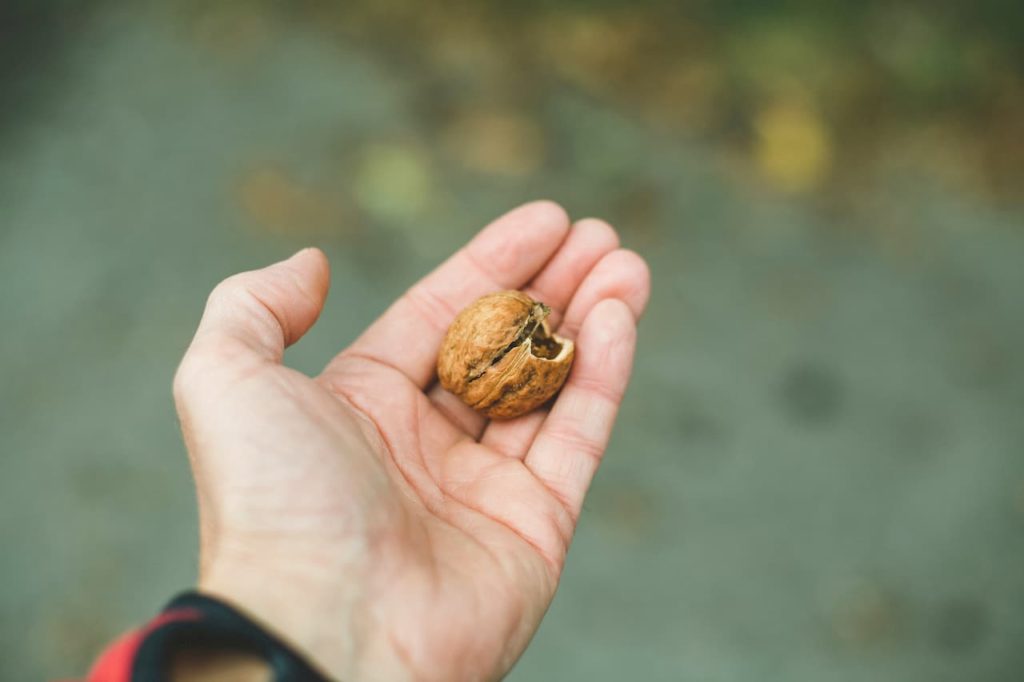
Walnuts and robotic mowers with blade discs
When it comes to robotic mowers that have a blade disc as their mowing mechanism, you should be especially careful if you have a walnut tree in your yard. The blades dull quickly, even if only a few walnuts are still lying around, and they may even break.
Unfortunately, you will have to scour the lawn regularly for walnuts and make sure you collect all of them.
Is there any protection against walnuts for robotic mowers with blade discs? In some models it is possible to install a grid-like blade protection. As already mentioned, I have only seen do-it-yourself constructions so far. Some people are successful with making their own out of metal mesh. I will try to provide something like this soon.
Walnuts and robotic mowers with star crosses
Robotic mowers with star crosses get along much better with walnuts than do blade disc units. Their blades do not dull as quickly and above all, they do not break. However, you should not take this as a go-ahead to use your robotic mower as your personal moving nutcracker.
It doesn’t matter if there are a few walnuts lying around, but you shouldn’t leave huge quantities on the ground. Even with a robotic mower with a star cross it is advisable to regularly collect all the walnuts lying around, you just don’t have to do it as often as you would with a robotic mower that has a blade disc.
What else you can do concerning walnuts and similar items
Another possibility is to adjust the cutting height. If you set the cutting height to 4 inch, which is the maximum setting on most robotic mowers, the blades will not come into contact with most walnuts. By the way, this also works with chestnuts, acorns and the like.
Which robotic mowers can handle tree debris best?
As you’ve probably noticed by now, star cross mowing units are generally more robust and can handle objects on the lawn a little better. They become less dull, are more durable, and can chop up things that a blade disc can only scratch, at best.
It should therefore be clear that robotic mowers with star crosses tend to be more suitable if you have a lot of leaves, fallen fruit, branches, pinecones, or nuts on your lawn and cannot clear them away very regularly.
Here I’ve compiled a list of some robotic mowers with star crosses:
| Model | Rotary mower type | Maximum Area Output (Acres) |
|---|---|---|
| AMBROGIO L200 Carbon Blackline | Sternmesser | 0.45 |
| AMBROGIO L250i Elite GPS | Sternmesser | 1.25 |
| AMBROGIO L350i Elite GPS | Sternmesser | 1.75 |
| AMBROGIO L400 | Sternmesser | 2.5 |
| AMBROGIO L60 Deluxe | Sternmesser | 0.05 |
| AMBROGIO L60 Elite | Sternmesser | 0.05 |
| AMBROGIO L85 Elite | Sternmesser | 0.55 |
| ROBOMOW RC306 | Sternmesser | 0.375 |
| ROBOMOW RS612 | Sternmesser | 0.75 |
| ROBOMOW RS622 | Sternmesser | 0.75 |
| ROBOMOW RS630 | Sternmesser | 1.24 |
| ROBOMOW RX20 | Sternmesser | 0.05 |
What about robotic mowers with blade discs?
In this article you might get the impression that robotic mowers with star crosses are in general better than robotic mowers with blade discs. But this is not true: they are just better suited for coarser work.
Robotic mowers with blade discs do have some advantages over robotic mowers with star crosses. For example, they are quieter and consume less energy. They are also somewhat safer in that they tend not to cause quite as serious of wounds as a robotic mower with a star cross in the case an accident occurs. In addition, many robotic mowers with blade discs have a greater safety distance between the mowing unit and the outer shell.
